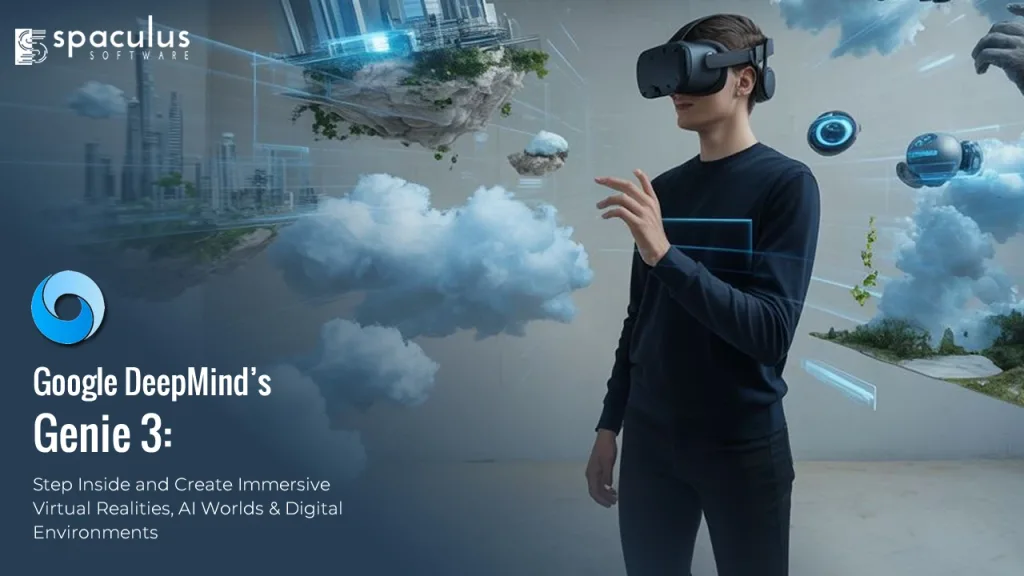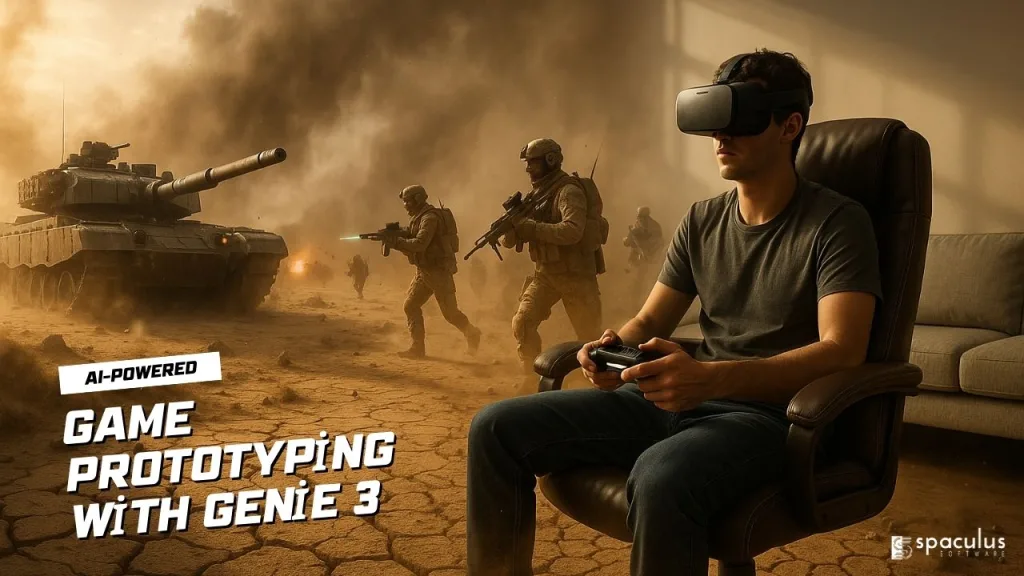
Genie 3 is DeepMind’s newest “world model” — an AI system that turns plain text prompts into playable, explorable environments in real time.
Type something like “tropical island at sunset with wooden huts and moving waves,” and within seconds, Genie 3 will create that scene. You can walk around inside it, change weather, add objects, or spawn characters — all while the scene keeps running. It works at 720p, 24 frames per second, and can hold a coherent environment for several minutes, remembering where things were for about one minute.
This isn’t a game engine like Unreal or Unity. There are no hand-coded physics or pre-built 3D assets. Genie 3 generates each frame on the fly using a trained model that predicts what comes next based on previous frames and your actions. Visual consistency is an emergent property of the training data, not something manually programmed.
DeepMind positions Genie 3 as both a research milestone and a tool for AI agent development — a step towards AI systems that can navigate and adapt to dynamic environments without relying on handcrafted simulations.
For founders, CEOs, and CTOs, Genie 3 signals a shift in how digital environments can be created, tested, and iterated.
Rapid prototyping becomes instant
Instead of hiring a team to model, texture, and render an environment, you can create a playable space by typing a sentence. Imagine building a virtual retail store, event layout, or training ground in minutes — then editing it in real time during a meeting.
AI agent training becomes scalable
If you’re building AI systems — whether for robotics, autonomous navigation, or customer service — you need varied, unpredictable environments to test adaptability. Genie 3 lets you generate endless scenarios without building them from scratch, cutting development costs and timelines.
Better cross-team collaboration
Rather than reviewing static slides or wireframes, marketing, product, and engineering teams can walk through a concept together. Decisions are faster when everyone can experience the same interactive scene.
Lowering the barrier to immersive design
Historically, immersive 3D design required specialized talent and software. Genie 3 hints at a future where the skill barrier drops — enabling small teams to compete with larger ones in creative speed.
From DeepMind’s official announcement and technical brief:
Genie 2, released earlier in 2024, could turn a single image into a short playable scene. It lasted 10–20 seconds on average, occasionally stretching to a minute. Interactivity was limited, and you couldn’t edit the scene mid-run.
Genie 3 takes a leap forward:
Strengths
Limitations
While Genie 3 is not production-ready, there are smart ways to start thinking about its integration.
Today
6–18 months
2–5 years
Gaming: While current fidelity limits Genie 3’s role in production games, its instant generation could speed up level design and early prototyping. Expect studios to integrate similar AI tools internally before public release.

Enterprise Operations: Companies could visualize supply chain setups, facility layouts, and customer flows dynamically.
Education: Schools and training programs could spin up interactive learning environments instantly, making simulations affordable and accessible.
Robotics: AI-powered robots could train in diverse virtual spaces, reducing the need for physical prototypes.
Architecture & Real Estate: Once fidelity improves, architects could generate explorable drafts directly from client descriptions.

While Genie 3 offers incredible potential, there are serious considerations that founders, CEOs, and CTOs need to factor in before adopting or building on similar AI-generated world models.
1. Data Security and Intellectual Property
If you integrate AI world models into enterprise workflows, you’ll need clarity on what data (prompts, assets, user behavior) is stored or used for further training. Without strong contractual protections, proprietary design concepts could end up informing future models outside your control.
2. Regulatory Uncertainty
Generative simulations that resemble real-world locations, products, or brands may face regulatory scrutiny. For example, using an AI model to replicate competitor facilities or environments could raise IP or ethical questions.
3. Model Bias and Representation
World models are trained on vast datasets. If those datasets carry cultural or spatial biases, the generated environments may unintentionally misrepresent real-world contexts — which could affect design accuracy, inclusivity, and brand image.
4. Technical Dependency Risk
If a business builds internal processes around a proprietary world model (like Genie 3) that it doesn’t own, it becomes dependent on the provider’s uptime, pricing, and roadmap. Any sudden API pricing changes, access restrictions, or service shutdowns could disrupt operations.
5. Scalability vs. Cost
Running high-fidelity real-time generative worlds at enterprise scale will require significant compute. Until infrastructure costs drop or edge-optimized models emerge, scaling these environments could be cost-prohibitive for certain use cases.
Genie 3 sits in a growing class of AI systems aimed at “world generation” — OpenAI, NVIDIA, Meta, and several startups are pursuing related goals. But DeepMind’s emphasis on real-time interaction and agent training differentiates it from pure video or image generators.
If you lead a tech-driven company, track this space closely. The first vendor to offer a stable, API-accessible, high-fidelity text-to-world service could see massive enterprise adoption.
These answers will determine when Genie 3 (or its successor) crosses from research novelty to business-critical tool.
Spaculus Software’s role would be in bridging the gap between DeepMind’s research tool and a business-ready implementation — enabling companies to extract value from world-model technology without waiting years for a polished commercial release.
1. Building Integration Pipelines
Spaculus can develop middleware that connects a world model like Genie 3 to your existing tools — whether that’s Unity for game design, CAD software for architecture, or custom robotics training platforms. This means you could prompt a world in Genie 3 and seamlessly bring its output into your existing workflow.
2. Data Privacy Layers
By creating a private deployment or hybrid architecture, Spaculus could help ensure that your proprietary prompts and generated worlds stay within your infrastructure — not on a third-party’s servers — meeting security and compliance needs.
3. Workflow Automation
Spaculus Software can design automated processes where text prompts generate worlds, run AI agent tests, extract performance metrics, and feed results into analytics dashboards. That turns Genie 3 into a repeatable R&D tool, not just a demo.
4. Custom Business Logic in Generated Worlds
Instead of generic environments, Spaculus Software could embed industry-specific logic. For example:
5. Scalability and Cloud Optimization
Running real-time AI world generation is resource-intensive. Spaculus can build optimized deployment stacks, balancing GPU resources, caching strategies, and instance scaling — reducing cost while maintaining performance.
6. Future-Proofing
Genie 3’s current limits (720p, short sessions) will improve. Spaculus can architect systems so that, when higher fidelity, longer memory, or VR support arrives, upgrading requires minimal disruption.
Genie 3 is a research preview, but it points toward a future where immersive environments can be created as quickly as they can be described. For business leaders, the opportunity isn’t in deploying it today — it’s in understanding what workflows it could collapse, what capabilities it could unlock, and how to be ready when it becomes a product.
If you’re running a company that relies on simulation, design iteration, or interactive training, you should already be thinking about where a tool like this fits. Because when high-resolution, persistent, multi-agent, and VR-ready versions hit the market, the companies that have been experimenting from day one will be the ones that move fastest.